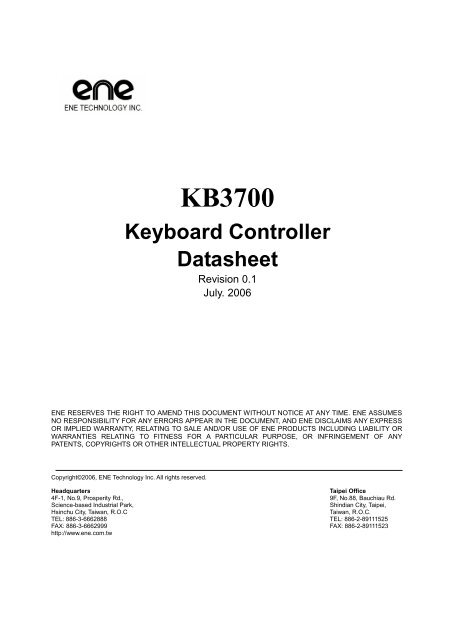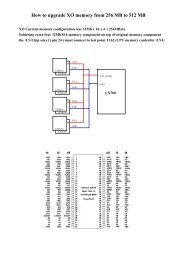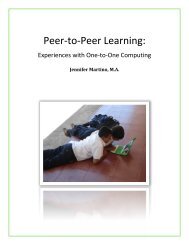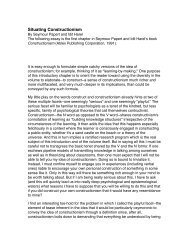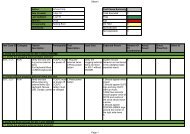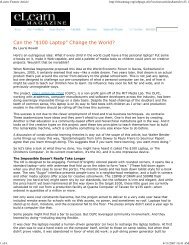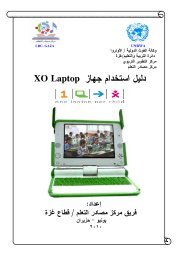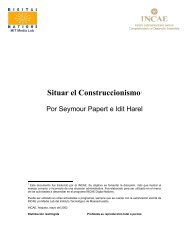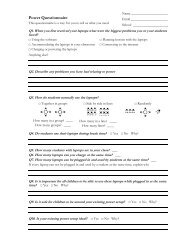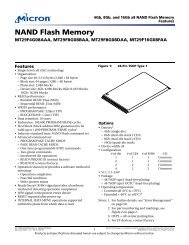KB3700
KB3700
KB3700
Create successful ePaper yourself
Turn your PDF publications into a flip-book with our unique Google optimized e-Paper software.
<strong>KB3700</strong> Keyboard Controller Datasheet4.8 LPC..................................................................................................................................... 224.8.1 LPC / FWH Functional Description ................................................................................ 224.8.1.1 LPC Decoding IO Ports................................................................................................ 224.8.1.2 LPC Decoding Memory Space...................................................................................... 224.8.2 LPC Registers Descriptions (Base address = FE90h, 16 bytes)...................................... 224.9 PS / 2 INTERFACE ................................................................................................................. 244.9.1 PS/2 Functional Description............................................................................................ 244.9.2 PS2 Registers Descriptions (Base Address = FEE0h, 32 bytes)...................................... 244.10 EC..................................................................................................................................... 264.10.1 EC Functional Description ............................................................................................ 264.10.1.1 Hardware EC Commands ................................................................................................................ 264.10.1.2 EC Status Register............................................................................................................................. 264.10.1.3 EC Command Register ..................................................................................................................... 264.10.1.4 EC Command Program Sequence ................................................................................................... 274.10.1.5 EC Index IO Mode ............................................................................................................................ 274.10.1.6 SCI Generation.................................................................................................................................. 274.10.1.7 SCI ID Table ...................................................................................................................................... 284.10.2 EC Register Descriptions (Base Address = FF00h, 32 bytes) ....................................... 284.11 GPWU............................................................................................................................... 324.11.1 GPWU Functional Description...................................................................................... 324.11.2 GPWU Register Descriptions (Base Address = FF30h, 96 bytes) ................................. 324.12 8051 MICROPROCESSOR .................................................................................................... 324.12.1 Interrupt Vectors Table................................................................................................... 324.12.2 SFR Map ........................................................................................................................ 334.12.3 SFR Descriptions ........................................................................................................... 345. ELECTRONIC CHARACTERISTICS ................................................................... 375.1 ABSOLUTE MAXIMUM RATING................................................................................................ 375.2 RECOMMENDED OPERATING CONDITION ................................................................................ 375.3 OPERATING CURRENT........................................................................................................... 376. PACKAGING INFORMATION ............................................................................... 396.1 64 LQFP ............................................................................................................................. 397. REVISION HISTORY ............................................................................................... 40Copyright©2006, ENE Technology Inc. 3
<strong>KB3700</strong> Keyboard Controller Datasheet1. Features1.1 Feature Summary Low Pin Count Host Interface (LPC) SIRQ supporting IRQ1, IRQ12, SCI I/O Address Decoding: KBC IO Port 60h/64h Programmable EC IO Port 62h/66h and 68h/6Ch Programmable 4-byte Index I/O ports to access internal registers One Programmable I/O write byte-address decodingX-Bus Interface (XBI) SPI Flash support, the operation frequency runs at least 50MHz. Addressable Memory range up to 24MB. 8051 64KB code memory can be mapped into 4 independent 16KB pages.8051 Microprocessor Industry 8051 Instruction set complaint with 3~5 cycles per instruction. Programmable 8/16/32 MHz clock Fast instruction fetching from XBI Interface 128 bytes and 2KB tightly-coupled SRAM 24 extended interrupt sources. Two 16-bit tightly-coupled timer8042 Keyboard Controller 8 Standard keyboard commands processed by hardware Each hardware command can be optionally processed by firmwareEmbedded Controller (EC) Five EC Standard Commands can be processed by hardware ACPI Specification 2.0 compliant Support customer command by firmware Programmable EC I/O port addressing (default 62h/66h)Analog To Digital Converter (ADC) 6 built-in ADCs with 8-bit resolution. The ADC pins can be alternatively configured as General Purpose Inputs (GPI).Copyright©2006, ENE Technology Inc. 4
<strong>KB3700</strong> Keyboard Controller DatasheetPulse Width Modulator (PWM) 5 built-in PWMs Selectable clock sources: 1MHz/64KHz/4KHz/256Hz. Configurable cycle time (up to 1 sec) and duty cycle.Watchdog Timer (WDT) 32.768KHz input clock with 20-bit time scale. 8-bit watchdog timer interrupt and reset settingGeneral Purpose Timer (GPT)Two 16-bit, two 8-bit general purpose timers with 32.768KHz resolutionGeneral Purpose Wake-Up (GPWU) All General Purpose Input pins can be configured to generate interrupts orwake-up event.General Purpose Input/Output (GPIO) All I/O pins are bi-direction and configurable All outputs can be optionally tri-stated All inputs equipped with pull-up, high/low active, edge/level trigger selection All GPIO pins are bi-direction, input and output. Max. 43 GPIOsPower Management Sleep State: 8051 Program Counter (PC) stoppedDeep Sleep State: Stop all internal clocks. Target power consumption ~10uA.Copyright©2006, ENE Technology Inc. 5
<strong>KB3700</strong> Keyboard Controller Datasheet<strong>KB3700</strong> 64-pin LQFPKB3920 144-pin LQFPChip Dimension 10x10 mm 2 20x20 mm 2Microprocessor 8051 8051Built-in SRAM 2048 + 128 bytes 2048 + 128 bytes8051 Clock 32 ~8 MHz (adjustable) 22~8 MHzFlash Memory Range 4M bytes (SPI) 1M bytes(ISA), 2M bytes (SPI)Flash I/F Clock 65~32 MHz (adjustable) 65/32 MHz (2 select 1)ADC 6 4DAC N.A. 4Watch Dog Timer 1 1PWM 5 4External PS/2 devices 2 3GPIOs Max 43 Max 89 pinsKB matrix scan N.A. 18x8FAN Controller N.A. 2General Purpose Timer 6 6SM BusN.A.2 InterfacesN.A.1 Internal ControllerHW KBC Standard Commands 8 8HW IKB Standard Commands N.A. 10HW EC Standard Commands 5 5TBD (target 12mA)15 mA(in Normal RUN)Power Consumption TBD (target 3mA in IDLE mode) 4 mA (in IDLE mode)TBD(target 500 uA in STOP mode) 10 uA( in STOP mode)Copyright©2006, ENE Technology Inc. 6
<strong>KB3700</strong> Keyboard Controller Datasheet1.2 Block DiagramCopyright©2006, ENE Technology Inc. 7
<strong>KB3700</strong> Keyboard Controller Datasheet2. Pin Assignment and Description2.1 Pin ListNo. Pin Name GPIO Alt. Output. Alt. Input Default Reset IOCELL1 GPIOE0 GPIOE0 BQC04HU2 GPIOE1 GPIOE1 BQC04HU3 GPIOE2 GPIOE2 BQC04HU4 GPIOE3 GPIOE3 BQC04HU5 SERIRQ BCC16H6 GPIO00 GPIO00 GA20 BQC04HU7 LFRAME# BCC16H8 LAD3 BCC16H9 GPIO01 GPIO01 KBRST# BQC04HU10 GPIO02 GPIO02 PLLCLK_REF2 BQC04HU11 LAD2 BCC16H12 LAD1 BCC16H13 VCC VCC14 LAD0 BCC16H15 GND GND16 GPIO03 GPIO03 PCICLK BCC16H17 GPIOE4 GPIOE4 BQC04HU18 GPIOE5 GPIOE5 BQC04HU19 GPIOE6 GPIOE6 BQC04HU20 GPIOE7 GPIOE7 BQC04HU21 GPIO04 GPIO04 PCIRST# BCC16H22 GPIO05 GPIO05 SCI# BQC04HU23 GPIO06 GPIO06 PWM0/E51_TXD BCC16H24 GPIO07 GPIO07 PWM1/E51_CLK E51_RXD BCC16H25 GPIO08 GPIO08 PWM2 BCC16H26 GPIO09 GPIO09 PWM3 BCC16H27 GPIO0A GPIO0A PWM4 BCC16H28 GPIO0B GPIO0B E51_TMR0 BQC04HU29 GPIO0C GPIO0C E51_TMR1 BQC04HU30 GPIO0D GPIO0D E51_TXD ECRST# BQC04HU31 GPIO0E GPIO0E PLLCLK32 E51_INT0 ECRST# BQC04HU32 GPIO0F GPIO0F POR E51_INT1 BQC04HU33 GPIOE8 GPIOE8 BQC04HU34 AD3 IQA35 AD4 IQA36 AD5 IQA37 GPIO10 GPIO10 BQC04HU38 AD0 IQA39 AD1 IQA40 AD2 IQA41 AVCC AVCC42 AGND AGND43 GPIO11 GPIO11 PSCLK1 PSCLK1 BQC04HU_10K44 GPIO12 GPIO12 PSDAT1 PSDAT1 BQC04HU_10KCopyright©2006, ENE Technology Inc. 8
<strong>KB3700</strong> Keyboard Controller Datasheet45 GPIO13 GPIO13 PSCLK2 PSCLK2 BQC04HU_10K46 GPIO14 GPIO14 PSDAT2 PSDAT2 BQC04HU_10K47 GPIO15 GPIO15 TEST_CLK BQC04HU48 GPIO16 GPIO16 TP_CLK_TEST BQC04HU49 GPIOEC GPIOEC BQC04HU50 GPIOED GPIOED BQC04HU51 GPIOEE GPIOEE BQC04HU52 GPIOEF GPIOEF BQC04HU53 GPIO17 GPIO17 CLK TP_PLL_TEST BQC04HU54 GPIO18 GPIO18 CLK32MHz(8051) TP_ISP_MODE BQC04HU55 GPIO19 GPIO19 CLK16MHz(peri) TP_IO_TEST BQC04HU56 GPIO1A GPIO1A CLK32MHz(WDT BQC04HU57 GPIO1B GPIO1B BQC04HU58 SPIDI BCC16H59 SPIDO BCC16H60 SPICLK BCC16H61 SPICS# BCC16H62 VCC VCC63 VCC18 VCC1864 GND GND2.2 I/O Buffer TableIO Name Descriptions ApplicationsBQC04HU Schmitt trigger, 2~4mA Output / Sink Current, with , Input / Output / Pull Up Enable GPIOBQC04HU_10K Schmitt trigger, 2~4mA Output / Sink Current, with , Input / Output / 10KΩ Pull Up EnableGPIOBCC16H 8~16mA Output / Sink Current , 5 V Tolerance, Input / Output Enable LPC InterfaceIQA Mixed mode IO, ADC Enable, with GPI, 2~4mA Sink Current, Input Enable ADC, GPIN2.3 I/O Buffer Characteristic TableIO NamePortIO I O OE IE AE 5VTor PEOutput / SinkCurrentBQC04HU V V V V V 40K (typ.) 2~4mABQC04HU_10K V V V V V 10K (typ.) 2~4mABCC16H V V V V V V 8~16mAIQA V V V V2.4 I/O Naming ConventionI IO Buffer InputO IO Buffer OutputOE IO Buffer Output EnableIE IO Buffer Input EnablePE IO Buffer Pull High EnableAE IO Buffer Analog mode Enable(AE > OE)Q Schmitt TriggerH 5V ToleranceCopyright©2006, ENE Technology Inc. 9
<strong>KB3700</strong> Keyboard Controller Datasheet3. Pin Descriptions3.1 Hardware trapHardware trap pins will latch the external signal levels at the rising edge of ECRST#. Either a Highor Low value will be stored internally to serve as control signals as described below.For normal application, there is no application component required for selecting the normal modebecause <strong>KB3700</strong> build-in internal pull up resistor to select the right operation mode.After <strong>KB3700</strong> booted, the pull up resistor may be disabled by GPIO register setting.Pin name 64 Pins HW Strap DescriptionTP_TESTTP_TEST: Clock Test Mode (for testing and ISP Mode)(GPIO16)48 Low: Clock Test Mode Enable. (all internal logic will use GPIO15 as clocksource)TP_PLL: PLL Test Mode (for testing)TP_PLL(GPIO17)TP_ISP(GPIO18)TP_IO(GPIO19)535455LOW: PLL Test Mode EnableGPIO0E is PLL 32MHz clock output.GPIO0F is Power On Reset output.HIGH: Normal operation (MUST, Power-On Default)TP_ISP: ISP Mode (for programming external SPI flash)LOW: ISP Mode EnableHIGH: Normal operation in not ISP mode (MUST, Power-On Default)TP_IO: IO Test Mode (for testing)LOW: IO Test Mode EnableHIGH: Normal operation (MUST, Power-On Default)4. Module DescriptionsThe following table gives the corresponding memory map for accessing. Each module will bedescribed detail in the individual sections.No. Abbreviation Device Full Name Address Range Size (Byte)1 Flash Program space mapped to system BIOS 0000h~F3FFh 61K2 XRAM Embedded SRAM F400h~FBFFh 2K3 GPIO General Purpose IO (include ADC, DAC) FC00h~FC7Fh 1284 KBC Keyboard Controller FC80h~FC9Fh 325 PWM Pulse Width Modulation FE00h~FE1Fh 326 GPT General Purpose 16-bit timer FE50h~FE6Fh 327 WDT Watchdog Timer FE80h~FE8Fh 161K8 LPC Low Pin Count FE90h~FE9Fh 169 XBI X-BUS Interface FEA0h~FECFh 4810 PS2 PS2 FEE0h~FEFFh 3211 EC Embedded Controller (hardware EC Space) FF00h~FF1Fh 3212 GPWU General Purpose Wake-up (hardware EC Space) FF20h~FE7Fh 96Copyright©2006, ENE Technology Inc. 10
4.1 Chip Architecture4.1.1 Power Planes<strong>KB3700</strong> Keyboard Controller DatasheetThere are 2 power planes in this chip. One is used for all logic, the other is used for Analogparts (ADC).4.1.2 Clock DomainsThere are 4 clock domain in <strong>KB3700</strong>. Flash chip interface clock. The clock default in 16MHz, and can be to 32MHz or 64MHz. 8051 / XBI use high clock (setting in CLKCFG, FF0Dh), ranges from 22~4MHz. WDT uses 32.768KHz clock. WDT default use internal 32KHz clock. The WDTCFG bit 7options can switch WDT clock to external 32KHz clock oscillator. Other peripherals (GPWU, PWM,.) use low clock (setting in CLKCFG, FF0Dh), rangesfrom 8~2MHz.4.1.3 Reset DomainsThis chip builds in power on reset. There is also a input reset signal (ECRST#) for global reset.WDT reset can reset almost all logic, except WDT and GPIO modules. The WDT reset can beset to only reset 8051 by EC register (PXCFG, FF14h).There is additional 8051 reset source from EC register (PXCFG, FF14h).4.2 GPIO4.2.1 GPIO Functional DescriptionMulti-function pin Output Function Selection (FS) bit = 0, is set for GPIO Output Function,and FS bit = 1, is set for Alternative Output. The alternative input function is enabled by InputEnable register (IE), and is not affected by FS register.Register Register Full NameOffsetDef BnkAbbreviation Bit Attr Description00~0310~1520~GPIOFS00GPIOFS08GPIOFS10GPIOFS18GPIOOE00GPIOOE08GPIOOE10GPIOOE18GPIOEOE0GPIOEOE8GPIOD00GPIO 00~1B Output Function Selection (0: GPO, 1: Alternative Output)00h: GPIOFS00 for GPIO00~07 07~0 R/W01h: GPIOFS08 for GPIO08~0F 0 FC02h: GPIOFS10 for GPIO10~17 003h: GPIOFS18 for GPIO18~1B 0GPIO 00~1B Output Enable (0: Output Disable, 1: Output Enable)10h: GPIOOE00 for GPIO00~07 011h: GPIOOE08 for GPIO08~0F 07~0 R/W12h: GPIOOE10 for GPIO10~17 0 FC13h: GPIOOE18 for GPIO18~1B 014h: GPIOEOE0 for GPIOE0~7 015h: GPIOEOE8 for GPIOE8~F (GPIOE9~A is N.A.) 0GPIO 00~1B Data OutputFCGPIOD08 7~0 R/W 20h: GPIOD00 for GPIO00~07 0Copyright©2006, ENE Technology Inc. 11
<strong>KB3700</strong> Keyboard Controller Datasheet21h: GPIOD08 for GPIO08~0F 022h: GPIOD10 for GPIO10~17 023h: GPIOD18 for GPIO18~1B 024h: GPIOED0 for GPIOE0~7 025h: GPIOED8 for GPIOE8~F (GPIOE9~A is N.A.) 0GPIOIN00GPIO 00~1B Input Status30~36GPIOIN08GPIOIN10GPIOIN18GPIOEIN0GPIOEIN8GPIADIN7~0 R/W30h: GPIOIN00 for GPIO00~0731h: GPIOIN08 for GPIO08~0F32h: GPIOIN10 for GPIO10~1733h: GPIOIN18 for GPIO18~1B34h: GPIOEIN0 for GPIOEIN0~735h: GPIOEIN8 for GPIOEIN8~F (GPIOEIN9~A is N.A.)36h: GPIAD0 for GPIAD0~50FC40~45GPIOPU00GPIOPU08GPIOPU10GPIOPU18GPIOEPU0GPIOEPU8GPIO 00~1B Pull Up Enable7~0R/WC140h: GPIOPU00 for GPIO00~07 041h: GPIOPU08 for GPIO08~0F 2042h: GPIOPU10 for GPIO10~17 E043h: GPIOPU18 for GPIO18~1B 0344h: GPIOEPU0 for GPIOE0~7 045h: GPIOEPU8 for GPIOE8~F (GPIOE9~A is N.A.) 0FC50~53GPIOOD00GPIOOD08GPIOOD10GPIOOD18GPIO 00~1B Open Drain Enable7~0 R/W50h: GPIOOD00 for GPIO00~07 051h: GPIOOD08 for GPIO08~0F 052h: GPIOOD10 for GPIO10~17 053h: GPIOOD18 for GPIO18~1F 0FCGPIO 00~1B Input Enable60~66GPIOIE00GPIOIE08GPIOIE10GPIOIE18GPIADIE7~0 R/W60h: GPIOIE00 for GPIO00~07 061h: GPIOIE08 for GPIO08~0F 2062h: GPIOIE10 for GPIO10~17 E063h: GPIOIE18 for GPIO18~1B 0364h: GPIOEIN0 for GPIOE0~7 065h: GPIOEIN8 for GPIOE8~F (GPIOE9~A is N.A.) 0FC66h: GPIAD0 for GPIAD0~5 0GPIO MISC70 GPIOMISC7~2 RSV 01 R/W Select GPIO07 as E51_CLK. 00 R/W Select GPIO06 as E51_TXD. 0FCCopyright©2006, ENE Technology Inc. 12
<strong>KB3700</strong> Keyboard Controller Datasheet4.2.2 GPIO Input / Output Control StructureGPIOFSAlt. Output EnableGPIOODGPIOOE0110GPIOD 0Alt. Output 1GPIOFSOEOutput BufferIO PINGPIOPINPull up EnablePEInput BufferAlt InputIEIEPEGPIOPINInput BufferINPUT PINAlt InputIEGPIOFSAlt. Output EnableGPIOODGPIOOE0110GPIODAlt. Output01OEOUTPUT PINGPIOFSOutput BufferCopyright©2006, ENE Technology Inc. 13
4.3 KBC4.3.1 KBC Functional Descriptiona. IO 60h: KBC Data Input Register (KBDIN):<strong>KB3700</strong> Keyboard Controller DatasheetWhen the host writes I/O ports 60h and 64h, the data is stored in KBDIN. At the sametime, the input buffer full flag (IBF bit in KBSTS) is set. The input data stored in KBDIN isdirectly fetched by the command processing logic and IBF is also cleared automatically.b. I/O 60h: KBC Data Output Register (KBDOUT)The data responded to the host is generated by the hardware circuit. The data is pushedinto KBDOUT and the output buffer full flag (OBF bit in KBSTS) is set automatically.<strong>KB3700</strong> can be configured to generate interrupts to the host when OBF is set. OBF isautomatically cleared after that the host reads KBDOUT (through I/O port 60h).c. I/O 64h: KBC Status Register (KBSTS)The host read it through I/O port 64h. The bit format of this register is as follows:Status Bit Name Description7 Parity Error PS/2 Bus parity error.6 General Timeout PS/2 Bus timeout.5 Aux OBF KBDOUT data is from PS/2 auxiliary device.4 Uninhibited Keyboard is not inhibited.3 A2 Address of the previous write cycle.2 System Flag POST of the system is finished.1 IBF Input Buffer Full flag.0 OBF Output Buffer Full flag.d. Hardware Processed CommandThe following standard commands are processed by hardware directly.Value Command Description20hC0hD0hD1hD2hD3hE0hRead Command ByteRead P1Read P2Write P2Write KB Output BufferRead the command byte of KBCResponse Command byteRead the input port of 8042 P1. Because there is no real 8042 in the chip, this commandjust emulates the function.Response Always return 00hRead the output port of 8042 P2. Because there is no real 8042 in the chip, this commandjust emulates the function.Response Bit1 is the status of GA20Write the output port of 8042 P2. Because there is no real 8042 in the chip, this commandwill just emulate the function and set/clear GA20 based on data bit 1.Argument Bit1 is the status of GA20Write data into KBDOUT as if it comes from the keyboard.Argument Keyboard dataWrite data into KBDOUT as if it comes from the auxiliary device.Write AUX Output BufferArgument Auxiliary dataRead Test InputRead the test inputs T0 and T1 of 8042. Because there is no real 8042 in the chip, thiscommand will just emulate the function.Response Always return 00hFEh KB Reset This command generates a 6us low pulse on KBRST#.Copyright©2006, ENE Technology Inc. 14
<strong>KB3700</strong> Keyboard Controller DatasheetOffset80h81h82h83h84h85h86h4.3.2 KBC Registers Descriptions (Base Address = FC80h, 32 bytes)Register Register Full NameAbbreviation Bit Attr DescriptionKBCCBKBCCFGKBCIFKBCHWENKBCCMDKBCDATKBCSTSKBC Command Byte (KBC command 20h/60h)7 RSV6 R/W Scan Code Conversion5 R/W Auxiliary Device Disable4 R/W Keyboard Device Disable3 R/W Inhibit Override2 R/W System Flag1 R/W IRQ12 Enable0 R/W IRQ1 EnableKBC Configuration7 R/W Keyboard Lock Enable6 R/W Fast Gate A20 Control5~4 RSV3 R/W Keyboard Lock2 RSVIBF Interrupt Enable.1 R/WThis bit enables KBC to generate interrupt to the 8051 at the rising edge ofIBF, when the KBC command being received will be bypassed to firmware forprocessing.0 R/WOBF Interrupt Enable.This bit enables KBC to generate interrupt to the core processor at the fallingedge of OBF.KBC Interrupt Pending Flag7~3 RSV2KBC firmware mode in processing flag,R/WC1Exit KBC firmware mode and re-enable hardware mode by writing 11 R/WC1 IBF interrupt pending flag0 R/WC1 OBF interrupt pending flagKBC Hardware Command Enable7 R/W FEh: KB Reset command processed by hardware6 R/W E0h: read test input command processed by hardware5 R/W D3h: write AUX output buffer4 R/W D2h: write KB output buffer3 R/W D1h: write P2 command processed by hardware2 R/W D0h: read P2 command processed by hardware1 R/W C0h: read P0 command processed by hardware0 R/W 20h: read command byte processed by hardwareKBC Command Buffer7~0 RO The data written to I/O port 64h will be stored in this register.KBC Data Input / Output Buffer7~0 R/WWriting to this register will cause the output buffer full flag OBF to be set. Thehost can read this register through I/O port 60h.KBC Host StatusParity Error.7 R/W When PS/2 protocol has a parity error, this bit will be set to high. This bit isalso used as port indicator for PS/2 active multiplexing mode.TimeOut.6 R/W When PS/2 protocol has a timeout error, this bit will be set to high. This bit isalso used as port indicator for PS/2 active multiplexing mode.5 R/W Auxiliary Data Flag4 RO Uninhibited3 RO Address (A2)2 RO System Flag1 R/WC1 IBF, write IBF = 1 to clear IBF0 R/WC1 OBF, write KBCDAT will set OBF to 1. Write OBF = 1 to clear OBFDef Bnk40 FFh0 FFh0 FFh0 FFh0 FFh0 FFh0 FFh4.4 PWMCopyright©2006, ENE Technology Inc. 15
<strong>KB3700</strong> Keyboard Controller Datasheet4.4.1 PWM Functional DescriptionThere are 5 PWM channels with 8-bit resolution.PWM2,3,4 are controlled by the same configuration register in PWMCFG2 with 6 bit clockprescaler.The PWM Cycle Length defines the PWM cycle time in setting clock source. The PWM HighPeriod Length defines the PWM pulse high period length, should be less than Cycle Length.Here is the formula of PWM duty cycle.Duty Cycle = (PWM High Period Length+1)/(PWM Cycle Period Length+1) *100%Please note the following case:ConditionH > CH and C=0x00H=0x00, C=0xFFH=0xFF, C=0x00Always 1 (High)Always 1 (High)A short pluseAlways 1 (High)PWM Output1. Where H means High Period Length (PWMHIGH) ; C means Cycle Period Length (PWMCYCL)Please refer to the following PWM register description.2. To force PWM output Low, please force this pin to be GPIO mode and output low.Offset4.4.2 PWM Registers Descriptions (Base address_FE00h, 16 bytes)RegisterRegister Full NameAbbreviation Bit Attr DescriptionDef Bnk0 PWMCFG1 PWMHIGH02PWMCYCL03 PWMHIGH14 PWMCYCL1567PWMCFG2PWMCFG3PWMCFG4PWM Configuration 07~6 R/WPWM1 clock source selection0: 1us1: 64us2: 256us3: 4ms5 RSV 04 R/W PWM1 Enable 03~2 R/WPWM0 clock source selection0: 1us1: 64us2: 256us3: 4ms1 RSV 00 R/W PWM0 Enable 0PWM0 High Period Length 07~0 R/W The High Period Length of PWM should be small than Cycle Length. 0PWM0 Cycle Length 07~0 R/W The Cycle Length of a PWM cycle, includes high and low Length.PWM1 High Period Length 07~0 R/W The High Period Length of PWM should be small than Cycle Length. 0PWM1 Cycle Length 07~0 R/W The Cycle Length of a PWM cycle, includes high and low Length.PWM Configuration 2, 3, 47 R/W PWM2, 3, 4 Enable6 R/WPWM prescaler Clock Select0: peripheral clock(by clock setting in EC CLKCFG(FF0Dh)1: 1MHz clock(recommend set this bit to fixed clock in different clock setting)00FEFEFEFEFE0 FECopyright©2006, ENE Technology Inc. 16
<strong>KB3700</strong> Keyboard Controller Datasheet89ABCD5~0 R/W The 6-bit prescaler for PWM by selected clock.PWMHIGH2 PWM2, PWM3, PWM4 High Period LengthPWMHIGH3PWMHIGH4 7~0 R/W High byte (8 bits)PWMCYC2 PWM2, PWM3, PWM4 Cycle LengthPWMCYC3PWMCYC4 7~0 R/W High byte (8 bits)0 FE0 FE4.5 GPT4.5.1 GPT Functional DescriptionThere are 4 GPTs in <strong>KB3700</strong>. 2 GPTs are 16-bit, and the other 2 are 8-bit. ALL base on30.516 us (32.768KHz) clock, and are independent on clock setting in EC register.GPT0 and GPT1 are 8-bit timer.GPT2 and GPT3 are 16-bit timer.Offset4.5.2 GPT Register Descriptions (Base address = FE50h, 16 bytes)RegisterRegister Full NameAbbreviation Bit Attr DescriptionDef Bnk50GPTCFG51 GPTPF53 GPT055 GPT156575859GPT Configuration7~5 RSV4 R/W GPT test mode, the GPT base clock will be system clock3 R/W Enable GPT3 counting and GPT3 interrupt2 R/W Enable GPT2 counting and GPT2 interrupt1 R/W Enable GPT1 counting and GPT1 interrupt0 R/W Enable GPT0 counting and GPT0 interruptGPT Pending Flag 07 WO GPT3 write 1 to restart 06 WO GPT2 write 1 to restart5 WO GPT1 write 1 to restart4 WO GPT0 write 1 to restart3 R/WC1 GPT3 Interrupt Pending Flag2 R/WC1 GPT2 Interrupt Pending Flag1 R/WC1 GPT1 Interrupt Pending Flag0 R/WC1 GPT0 Interrupt Pending FlagGPT0 Count Value7~0 R/WGPT1 Count Value7~0 R/WGPT2 Count ValueGPT2HGPT2L 7~0 R/WGPT3 Count ValueGPT3HGPT3L 7~0 R/WAfter GPT0 reach this value and interrupt will occur andGPT0 reset and counting from zero again.After GPT1 reach this value and interrupt will occur andGPT1 reset and counting from zero again.After GPT2 reach this value and interrupt will occur andGPT2 reset and counting from zero again.After GPT3 reach this value and interrupt will occur andGPT3 reset and counting from zero again.0 FE00000000FEFEFEFEFECopyright©2006, ENE Technology Inc. 17
4.6 SPI/ISP Device Interface4.6.1 SPI/ISP Functional DescriptionSPI includes several functions, as follows,<strong>KB3700</strong> Keyboard Controller Datasheet1. 2 code segments for 8051.2. Performance improvement: instruction sustain fetch, and pre-fetch3. flash write protection4. ISP should be enabled by hardware trap pin during hardware reset.1. The ISP packet format: If bit 7 th of 1 st byte is 1 means write packet, otherwise meansread.1. ISP write : [1000_XXXX] [WDATA]2. ISP read : [ 0000_XXXX] [RDATA]OffsetA0hA1hA4hA5hA6hA7hA8hA9hAAhABh4.6.2 SPI Registers Descriptions (Base address = FE70h, 16 bytes)RegisterRegister Full NameAbbreviation Bit Attr DescriptionXBISEG0XBISEG1XBIXIOENXBICFGXBICSXBIWE8051 Address Segment 0 (0000h-3FFFh) Mapping Configuration7 R/W Enable 8051 Code Space SEG0 Remapping5~0 R/W XBI address = XBISEG0*16k + 8051 address [13:0]8051 Address Segment 1 (4000h-7FFFh) Mapping Configuration7 R/W Enable 8051 Code Space SEG1 Remapping5~0 R/W XBI address = XBISEG1*16k + 8051 address [13:0]XBI XIO Enable7~0 R/W Enable related XIO channel (Only 4 channels)XBI Configuration7 R/W Enable XBI BUS IO buffer pull up6 R/W Enable 8051 sustain instruction fetch4 RO Enable WR# to flash3 R/WEnable extend SELMEM# and SELE51# 1 clock for RD# and WR# setupand hold time.2-0 R/W RD# and WR# command clock count= [2:0]XBI E51CS# Configuration7 R/W Enable E51CS# address 16~64K6 R/W5 R/W4 R/W3 RSVEnable Reset 8051 and XBI Segment Setting (XBISEG0~3)reset XBI registers A0~A3h(bank select) when WDT / Wakeup / ECRegister reset 8051.2 R/W Enable STOP and IDLE state let XBI state machine go to initial state.1 R/WEnable EHB Fast AccessA enhanced option to speed up EHB performance.0 R/W Select XIO select to SELIO# (set 1) or SELIO2# (set 0).XBI Write Enable7-0 WOSPIA0SPIA1SPIA2 7-0 R/WSPIDATXBI SPI Flash AddressWrite 00h to reset all rest mode.Write A3h to enable flash write cycles.Write C5h to SRAM test.SPIA0 = A7~0SPIA1 = A15~8SPIA2 = A22~16XBI SPI Flash Output / Input Data7-0 R/WOutput(write SPIDAT) / Input(read SPIDAT) data to/from SPI flashinterface.DefBnk0 FEh0 FEh0 FEh07h04hFEhFEh0 FEh0 FEh0 FEhACh SPICMD XBI SPI Flash Command 0 FEhCopyright©2006, ENE Technology Inc. 18
<strong>KB3700</strong> Keyboard Controller Datasheet7-0 R/WThe issued SPI command to SPI flash chip. The write to this register willstart the SPI accessing, so that the SPIA2~0 and SPIDAT should be readybefore SPICMD is written.SPICMD support command :01h Write Status Register02h Byte Program03h Read04h Write Disable05h Read Status Register06h Write Enable0Bh High Speed Read20h Sector Erase (SST)50h Enable Write Status Register (SST)52h Block Erase (SST)60h Chip Erase (SST)C7h Chip Erase (PCM, NexFlash)D7h Sector Erase (PCM)D8h Block Erase (PCM, NexFlash)SPI Flash Configuration / Status7 R/W Enable DPLL for ISP mode6 R/W SPI Flash Offset Read Command Enable. (32h)5 R/WSPI Flash Short Read Command Enable. (31h, 30h)A23~16 will not be used. A16 = 1 if 31h command. A16=0 if 30h command.The address phase will only contain A15~0, and don't care fast modeenable bit of SPICFG bit 2.ADhSPICFG4 R/W3 R/W2 R/W1 ROSPICS# force output low.After set this bit, the protocol will control by firmware. The SPICMD willoutput to SPI BUS each time the write operation to SPICMD.The SPIDAT will store the read operation data from SPI BUS.SPICMD write enable.Enable SPICMD write action to start SPI flash protocol accessing.Enable SPI Flash Dummy Byte for Read Command.Enable SPI flash read by 8051 instruction by Fast Mode (High SpeedRead) 0Bh command.SPI flash accessing in progress status.Use this bit to check if the SPI accessing is finished or not.0 R/W Enable SPICMD follow with a SPI status check until Busy flag cleared.00 FEhAEhSPIDATRSPI Flash Output Data for Read Compare7-0 RO Output data to SPI flash interface.0 FEhSPI Flash Configuration 2AFhSPICFG27-4 RSV Reserved.0 FEh3-0 R/W SPI Offset / Short Read Command high nibble.Offset0124.6.3 ISP Registers Descriptions (8 bytes)RegisterRegister Full NameAbbreviation Bit Attr DescriptionISPIA0ISPIA1ISPA23 ISPDATISP SPI Flash Address7-0 R/WSPIA0 = A7~0SPIA1 = A15~8SPIA2 = A22~16ISP SPI Flash Output / Input Data7-0 R/WOutput(write SPIDAT) / Input(read SPIDAT) data to/from SPI flashinterface.4 ISPCMD ISP SPI Flash Command 0Def00Copyright©2006, ENE Technology Inc. 19
<strong>KB3700</strong> Keyboard Controller Datasheet7-0 R/WThe issued SPI command to SPI flash chip. The write to this register willstart the SPI accessing, so that the SPIA2~0 and SPIDAT should be readybefore SPICMD is written.SPICMD support command :01h Write Status Register02h Byte Program03h Read04h Write Disable05h Read Status Register06h WriteEnable0Bh High Speed Read20h Sector Erase (SST)50h Enable Write Status Register (SST)52h Block Erase (SST)60h Chip Erase (SST)C7h Chip Erase (PCM, NexFlash)D7h Sector Erase (PCM)D8h Block Erase (PCM, NexFlash)5 ISPCFG6 ISPDATRISP SPI Configuration / Status7 ~ 5 R/W4 R/W3 R/W2 R/W1 ROSPICS# force output low.After set this bit, the protocol will control by firmware. The SPICMD willoutput to SPI BUS each time the write operation to SPICMD.The SPIDAT will store the read operation data from SPI BUS.SPICMD write enable.Enable SPICMD write action to start SPI flash protocol accessing.SPI flash read by 8051 instruction by Fast Mode (High Speed Read) 0Bhprotocol.SPI flash accessing in progress status.Use this bit to check if the SPI accessing is finished or not.0 R/W Enable SPICMD follow with a SPI status check until Busy flag cleared.ISP SPI Flash Output Data for Read Compare7-0 RO Output data to SPI flash interface.ISP SPI ISP RS232 Baud Rate Setting007ISPSCON3***In ISP mode, 8051_SFR(SCON2) always 07-0 WOwrite this reg to program 8051_SFR(SCON3)Default: SCON3 = 0x89, baud-rate = 57600 (while 8051 clk = 8Mhz)0set SCON3 = 0x45 for baud-rate =115200 (while 8051 clk = 8Mhz)7~4 RSVReserved3~0 RO SPI Offset / Short Read Command high nibble.3*** Please note, ISPSCON3 register gives different bitmap definition according to access. For write operation, pleaserefer to the yellow part, and read operation please refer to the green part.Copyright©2006, ENE Technology Inc. 20
<strong>KB3700</strong> Keyboard Controller Datasheet4.7 WDT4.7.1 WDT Functional DescriptionWDT timer clock uses 32.768 KHz oscillator clock and base unit is 64ms.WDT register can only be reset by power on reset and ECRST#.WDT range is between 64 ms to 16 seconds.WDT reset time is between 128ms to 32 seconds.WDT reset can reset all logic in the chip, except GPIO registers. Thus, the GPIO setting canbe preserved after WDT reset occurred. The WDT reset can optionally be set only to reset 8051logic in EC register space.4.7.2 WDT Registers Descriptions (Base address = FE80h, 16 bytes)OffsetRegisterAbbreviationRegister Full NameBit Attr DescriptionDef BnkWDT Configuration7 R/WWDT Extended Bits Enable0: WDT is 20-bit timer (normal setting).1: WDT is 24-bit timer (setting for PLLLOW in STOP mode).If EC CLKCFG.7 (PLLLOW Enable) is set, the WDT clock will become PLLoutput clock automatically. Set this bit to 1 before enter STOP mode to let WDTbecome 24-bit timer by 1~2MHz PLL output clock.80 WDTCFG6~3 R/WForce to disable WDT by writing 1001b to this field.Write 1011b to set WDT be shorter timer. (Enable WDT shorter test mode).Write 1111b to disable WDT shorter test mode.0 FE2 R/WWDT Clock Selection for testing0: WDT clock is from WDT Clock Selection 2 (normal setting).1: WDT clock is PLL output / 2 (i.e. 16MHz as PLL output 32MHz, maybestopped at STOP mode. This option is only for testing).1 R/W Enable WDT interrupt (WDT reset warning)0 R/WEnable WDT reset, and reset WDT timer,the WDT timer and 2 pending flags will be reset and count from zero again.If the WDT and reset after a interrupt occurred, the next interrupt will occurredafter 16 seconds.WDT Pending Flag7~5 RSV81 WDTPF1 R/WC1WDT interrupt pending, WDT half timeout flag. If this bit is set, the followingWDT timeout event will cause a WDT reset signal to system.0 FE0 R/WC1WDT reset event pending flag (the last WDT reset was ever happened),WDT reset will assert if WDT count to WDT and WDT interrupt is pending.WDT 8-bit Count Value (for Watch Dog Timer reset system)82 WDTCNT7~0 R/WAfter WDT counts to this value the half of WDT/2 , the interrupt will occur. TheWDT timer unit is 64ms.0 FE838485WDT19_12WDT11_04WDT03_00WDT Counter Value(for testing)0 RO Only for WDT testing.0 FECopyright©2006, ENE Technology Inc. 21
<strong>KB3700</strong> Keyboard Controller Datasheet4.8 LPC4.8.1 LPC / FWH Functional DescriptionThere are 5 address ranges on LPC/FWH interface will be responded by <strong>KB3700</strong> EC.1. Keyboard controller I/O ports: 60h, 64h2. Embedded controller I/O ports: 2 programmable I/O ports (default 62h/66h and 68h/6Ch)3. EC I/O Index and Data Ports: Through which the system host can access KB3925internal registers more efficiently than through EC commands F0h/F1h. The EC I/O Indexand Data Ports are two 8-bit registers with base address defined in FE92h and FE93h.Default Index Port ={002Dh, 002Eh}, Data port =002Fh.4. LPC/FWH memory access.5. Extended LPC write byte: can be programmed to port 80 and generate interrupt to 8051.4.8.1.1 LPC Decoding IO PortsThe keyboard I/O ports are 60h/64h, while the EC I/O ports are programmable inLPCEBA (FE98h, FE99h). The enable/disable of I/O ports decoding on LPC bus can beconfigured individually via register LPCCFG (FE95h).4.8.1.2 LPC Decoding Memory SpaceMemory Setting (LPCFWH bit 7,6) Memory Size Decoded BIOS Address00 256k (default)01 512k10 1M11 2M000C_0000 – 000F_FFFFFFFC_0000 – FFFF_FFFF000C_0000 – 000F_FFFFFFF8_0000 – FFFF_FFFF000C_0000 – 000F_FFFFFFF0_0000 – FFFF_FFFF000C_0000 – 000F_FFFFFFE0_0000 – FFFF_FFFF4.8.2 LPC Registers Descriptions (Base address = FE90h, 16 bytes)OffsetRegisterRegister Full NameAbbreviation Bit Attr DescriptionDefBnkLPC Status (Internal Use Only)7~2 RSV90hLPCSTAT1 R0 RSVLPC SIRQ is current in quiet/continuous mode1: quiet mode0: continuous mode0 FEh91hLPCSIRQLPC SIRQ Configuration0 FEh7 R/W Enable don't care A22 of FWH memory cycle6 R/W Enable SCI SIRQCopyright©2006, ENE Technology Inc. 22
<strong>KB3700</strong> Keyboard Controller Datasheet5 R/W Enable IRQ12 SIRQ4 R/W Enable IRQ1 SIRQ3 – 0 R/WSCI Serial IRQ channel0: no1:IRQ12:SMI#3:IRQ3…15:IRQ1592h93hLPCIBAHLPCIBALLPC Index IO Base Address7 – 0 R/WEC index mode IO port base address.The address should be 4 bytes align.FFh2ChFEhLPC FWH Configuration 094hLPCFWH7 – 6 R/WMemory Size (both for LPC Memory and FWH)00: 256KB01: 512KB10: 1MB11: 2MB0FEh95h96h97h98h99hLPCCFGLPCXBAHLPCXBALLPCEBAHLPCEBAL5 R/W Enable FWH memory cycle4 R/W Enable FWH IDSEL check3 – 0 R/W FWH IDLPC Configuration7 R/W Enable LPC memory write protection (including FWH)6 R/W Enable index IO port5 R/W Enable KBC IO port: 60h, 64h4 R/W Enable Extended IO port (IO write only)3 R/W Enable EC IO port2 R/W Enable LPC memory cycle (not including FWH)1 R/W Enable SIRQ fixed in continuous mode0 R/W Enable LPC CLKRUN#LPC Extended IO Base AddressOnly LPC byte write is supportedLPC EC IO Base AddressLPCEBAL bit 0 and bit 1 are not ignored for decodingAddress 2EF decoding and control in LPC(Internal Use Only)9Ah LPC_2EF B0h FEh80h00h80h00h62hFEhFEhFEhAddress 2EF decoding and control in LPC(NOTE: Internal Use Only)7~4 RSV9AhLPC_2EF3 R Decode IO(0x002F): 0:read_io_2f, 1:write_io_2f2 R/RWDecode IO(0x002F) r/w cycle, should cleared by FWWrite 1 to clear the value.1 R/W Enable interrupt of read/write_io(2f)0 R/W Enable decode read_io(2e), read/write_io(2f)9Bh7~0 RSVLPC_2F_DATA9Ch LPC_2F_DATA7~0 RO Read data for read_cycle_IO(2F)9DhLPC68CFGLPC 68/6Ch IO Configuration07 R/W Enable LPC I/F decode IO 68h, 6Ch6~2 RSVCopyright©2006, ENE Technology Inc. 23
<strong>KB3700</strong> Keyboard Controller Datasheet1 R/W IBF Interrupt Enable0 R/W OBF Interrupt EnableLPC 68h IO Command Status Register7 ROIO68/6Ch Busy Flag.The host is accessing the 68/6Ch IO. If this bit is set, the software doesn'tget the right of the 68/6Ch. This flag can be clear by write 6Ch = FFh.6 RO A2 (address bit 2) of the last write 68/6C IO.9EhLPC68CSR5~43 R/WC1 IBF Interupt Pending Flag2 R/WC1 OBF Interrupt Pending Flag.1 R/WC1 IBF0 R/WC1 OBF9FhLPC68DATLPC 6Ch IO Data Register7-0 R/W The data byte of current memory cycle.0 FEh4.9 PS / 2 Interface4.9.1 PS/2 Functional DescriptionThe PS2 Controller supports byte-level programming interface to PS2 devices, including IKBmodule. A PS/2 TX action will be pending if a PS/2 RX is active. After PS/2 RX is completed(received a byte), the TX will start transmitting to the specified port. PS2 Controller will maintainthe PS2 channel’s integrity in byte level. But the input signal should not be floating not drive lowif the PS2 channel is not used (MUST set correct GPIOFS and PS2CFG Enable PS2 ports).4.9.2 PS2 Registers Descriptions (Base Address = FEE0h, 32 bytes)OffsetRegisterRegister Full NameAbbreviation Bit Attr DescriptionDef BnkPS2 Configuration 07 RSV 06 R/W Enable PS2 port 2(TX/RX), disable will let PSCLK2 in low state 05 R/W Enable PS2 port 1(TX/RX), disable will let PSCLK1 in low state 0E0PS2CFG4 RSV 0FE3 R/W Enable interrupt of PS2 parity error 02 R/W Enable interrupt of PS2 TX timeout (clock >180us or request > 100ms) 01 R/W Enable interrupt of PS2 transmitted byte 00 R/W Enable interrupt of PS2 received byte 0E1PS2PFPS2 Pending Flag 0FE7 RSV 06 RO Received Byte Port is PS2 port 2 05 RO Received Byte Port is PS2 port 1 04 RSV 03 R/WC1 Interrupt Pending Flag of PS2 parity error 02 R/WC1 Interrupt Pending Flag of PS2 TX timeout 01 R/WC1 Interrupt Pending Flag of PS2 transmitted byte 0Copyright©2006, ENE Technology Inc. 24
<strong>KB3700</strong> Keyboard Controller Datasheet0 R/WC1Interrupt Pending Flag of PS2 received byte,Clear this bit will also clear bit 4~7 and RX timeout flag for receiving next bytefrom a PS/2 device.0PS2 Transmitter / Receiver Control 07 RSV 06 R/W Transmit Byte Port is PS2 port 2 05 R/W Transmit Byte Port is PS2 port 1 0E2PS2CTRL4 RSV 0FE3 WO Write 1 to force reset PS2 transmitter state, for emergency usage. 02 WO Write 1 to force reset PS2 receiver state, for emergency usage. 01 RO Flag of PS2 RX timeout 00 R/WEnable PS2 transmit data port,This bit should be set for transmitting a byte (write to PS2DATA) to a device.0PS2 DATA 0E3PS2DATA7~0 R/WWrite to start a byte transmitting to a PS2 device, and clear previous state.Read to get the data of received byte for a PS2 device.0FEPS2 Configuration 27-2 RSV Reserved.E4PS2CFG21 R/WPS2 protocol waiting time enable1. Wait 16 us after PS/2 bus is idle (clock-high,data-high), when PS/2 moduletransmits the command to divice.2. In the protocol of PS/2 module to device, the clock is low first then the datawaits 16 us to be low.0 R/W PS2CLK / PS2DAT input debounce enable. (0: 1 us; 1: 2 us)PS2 Pin Input Status7 RSV6 R/W PS2 Port 2 Clock5 R/W PS2 Port 1 ClockE5PS2PINS4 RSV3 RSV2 R/W PS2 Port 2 Data1 R/W PS2 Port 1 Data0 RSVPS2 Pin Output7 RSV6 R/W PS2 Port 2 Clock5 R/W PS2 Port 1 ClockE6PS2PINO4 RSV3 RSV2 R/W PS2 Port 2 Data1 R/W PS2 Port 1 Data0 RSVCopyright©2006, ENE Technology Inc. 25
<strong>KB3700</strong> Keyboard Controller Datasheet4.10 EC4.10.1 EC Functional DescriptionThere are 7 parts in EC:• Hardware EC Commands• EC Index IO mode• EC Extended IO Write• SCI Generation• Misc functions4.10.1.1 Hardware EC CommandsEC standard commands as described in ACPI 2.0 spec. are processed by hardware logicdirectly without the intervention of firmware. For EC extended commands, EC controller willforward them to 8051 and thereby processed by the firmware. The data and command/statusports are default to 62h and 66h respectively, and can be optionally mapped to other I/Oaddress space by KBC command 61h.4.10.1.2 EC Status RegisterTo read EC Status IO port register is described as follows:Status Bit Name Description7 Reserved Not used.6 Reserved Not used.5 SCIThis bit is set to 1 by the EC to indicate that there is/are a/more SCI event(s) in the SCIqueue. The system upon detecting this bit being set should thereafter query the SCI eventqueue (by issuing EC command 84h) to obtain the SCI ID number. EC standardcommands (80h,81h,82h,83h,84h) being received and completed by the EC will not causethe SCI bit to be set.4 Burst Enable The Burst Enable flag. 1=Enabled. 0=Disabled.3 Command or Data Flag2 Reserved Not used.1 IBF Input Buffer Full flag.0 OBF Output Buffer Full flag.1=Previous access port is command port (EC_CMD/EC_STS).0=Previous access port is data port (EC_DAT).4.10.1.3 EC Command RegisterThere are 7 valid EC Commands for EC command register (write IO 66h); other values are “don’tcare” by EC if being written.Value Command Description80h EC Read Read operation for an internal register in EC Space.81h EC Write Write operation for an internal register in EC Space.82h EC Burst Enable Enable EC burst operation mode.83h EC Burst Disable Disable EC burst operation mode.84h EC Query Query the SCI event queue.Others Firmware Command No responded from hardware EC. Firmware EC commands.Copyright©2006, ENE Technology Inc. 26
<strong>KB3700</strong> Keyboard Controller Datasheet4.10.1.4 EC Command Program SequenceCommand Byte Command Name Programming Sequence80h81h82h83h84hRead ECWrite ECBurst EnableBurst DisableQuery ECWrite EC_CMD with 80h (66h=80h)Wait SCI for IBF=0Write address byte to EC_DAT (62h=EC address)Wait SCI for OBF=1Read EC_DAT with data in (read data = 62h)Write EC_CMD with 81h (66h=81h)Wait SCI for IBF=0Write address byte to EC_DAT (62h=EC address)Wait SCI for IBF=0Write data byte to EC_DAT (62h = write data)Wait SCI for IBF=0Write EC_CMD with 82h (66h=82h)Wait SCI for OBF=1Read EC_DAT with 90h(Burst ACK)Write EC_CMD with 83h (66h=83h)Wait SCI for IBF=0Write EC_CMD with 84h (66h=84h)Wait SCI for OBF=1Read EC_DAT with SCI ID number (read data = 62h).4.10.1.5 EC Index IO ModeYou may use EC Index IO mode to access the KB3925 register space (F400h ~FFFFh). TheEC Index IO base is set in LPC register FE92h, FE93h. The base address + 1 is index high byteaddress. The base address + 2 is index low byte address. The base address + 3 is data port forreading from or writing to KB3925 internal register space. For example, set the base address inFE92h=00h, FE93h = 2Ch. The system IO write set 002Dh = FFh, 002Eh = 01h. The read / writeto 002Fh will read / write ECFV register (FF01h).4.10.1.6 SCI GenerationMost interrupts generated from KB3925 internal modules are connected to the 8051 core andare optionally to generate a SCI event. Each SCI has an associated SCI Enable and SCI Flagbits in EC Space 05h~0Ah. The three extended interrupt ports of 8051, each supporting 8interrupt channels, can accommodate totally 24 interrupt channels. The pulse-width of SCI isadjustable by setting SCICFG (default is low-active with 250ns pulse-width). Setting ECCFG bit0=1 (default=0, enabled) to disable the generation of SCI.In addition to the 24 SCI events generated by KB3925 internal hardware logic, 8051 firmwareor system BIOS can also generate a SCI event by writing the desired SCI ID into SCID register(0Bh) in EC space. The SCID should be first enabled in ECCFG bit3. The SCI IDs are definedas follows.Copyright©2006, ENE Technology Inc. 27
<strong>KB3700</strong> Keyboard Controller Datasheet4.10.1.7 SCI ID TableSCI ID Name PxI Description Priority00 Nothing N.A.01h02h03h04h05hN.A.N.A.N.A.N.A.N.A.06h~07 N.A. Not used.Indicates a EC Command is received from the Host. Alternatively also means nothinghappens08h WDT P0I.0 Indicates a Watchdog Timer event.09h RSV P0I.10Ah PS2 P0I.2 Indicates a PS2 event.0Bh KBC P0I.3 Indicates a KBC Host Interface event.0Ch RSV P0I.40Dh LPC P0I.5 LPC cycle interrupt0Eh ECFW P0I.6 EC firmware mode SCI (IBF/OBF SCI).SCID SCID P0I.7 Write SCI ID, Query value is SCID.10h RSV P1I.011h RSV P1I.112h RSV P1I.213hP1I.3 Not used.14h GPT0 P1I.4 Indicates a General Purpose Timer 0 event.15h GPT1 P1I.5 Indicates a General Purpose Timer 1 event.16h GPT2 P1I.6 Indicates a General Purpose Timer 2 event.17h GPT3 P1I.7 Indicates a General Purpose Timer 3 event.18h EXTWIO P3I.0 Indicates a Write Extended IO interrupt (Port80).19h1AhGPIO00~0F P3I.1 Indicates a GPIO00~0F event.GPIO10~1B P3I.2 Indicates a GPIO10~1B event.1Bh RSV P3I.31Ch RSV P3I.41Dh RSV P3I.51Eh RSV P3I.61Fh ADC P3I.7 Indicates a ADC updated event.Highest4.10.2 EC Register Descriptions (Base Address = FF00h, 32 bytes)Offset00h01h02hRegisterRegister Full NameAbbreviation Bit Attr DescriptionECHVECFVECHAEC Hardware Revision ID7 – 0 RO ECHV contains the current hardware version.EC Firmware Revision IDECFV is written by the 8051 firmware with its current firmware version for7 – 0 R/Wsystem software’s recognition. ADC test data input when ADC test enable.EC High Address7~4 RSVDef BnkA0 FFh0 FFhF FFhCopyright©2006, ENE Technology Inc. 28
<strong>KB3700</strong> Keyboard Controller Datasheet03h04h05h06h07h08h09h0Ah0Bh0ChOffsetSCICFGECCFG3 – 0 R/WSCI ConfigurationHigh-byte address of the 64KB EC address space. Used for standard ECcommands to access F000~FFFFh internal space. The default setting will lethost accessing the FF00~FFFFh (EC, GPWU, SMBus) space.7 R/W Enable the generation of SCI by standard EC commands (default enable)6 R/W Enable SCID port (Firmware generated SCI).5 R/W EC SCI pulse polarity; =0, low active; (default); =1, high active.4 R/W Enable EC SCI (set 1) from SCIIFx, default is enabled.3 – 0 R/WSCI pulse width = SCIPW x 64us, max length = 1 ms, as no width=0.IF width = 0, the pulse width will be a system clock.EC Configuration7 R/WEnable EPB Fast AccessA enhanced option to speed up EPB performance during accessing.6 R/W Test mode. Must be programmed to 0 for normal operation.5 R/W Enable hardware EC Read/Write command4 R/W Enable hardware EC Burst Enable/Disable command3 R/W Enable hardware EC Query command2 R/W Enable Extended IO port Interrupt to 80511 R/W0 R/WIBF Interrupt Enable, also be the Firmware Mode Enable.This bit enables KBC to generate interrupt to the 8051 at the rising edge ofIBF, when the KBC command being received will be bypassed to firmware forprocessing.OBF Interrupt Enable.This bit enables KBC to generate interrupt to the core processor at the fallingedge of OBF.SCIE0 EC SCI P0, P1, P3 Interrupt EnableSCIE1SCIE3 7 – 0 R/W Enable extended 8051 Port 0, 1, 3 Interrupt to SCISCIF0SCIF1SCIF3SCIDPMUCFGEC SCI P0, P1, P3 Interrupt Flag7 – 0 R/WC1Flags for extended 8051 Port 0, 1, 3 Interrupt to SCI.EC Query will clear the query SCI ID flag automatically, or write 1 to clearEC SCI ID Write Port for 8051 firmware to generate SCI event7 – 0 R/WPMU Control / Configuration8051 firmware can write to this port with SCI_ID value to generate a SCIevent. The host can use EC Query command to read this specified value.7 WO Enter STOP mode by writing this bit = 1, the same as 8051 PCON STOP6 WO Enter IDLE mode by writing this bit = 1, the same as 8051 PCON IDLE5 R/W Enable LPC cycle wake up from STOP mode.4 R/W MUST be set to '1' to enable wakeup feature.3 R/WEnable SCI to be one of wake up interrupt source8051 interrupt source will always exit Ultra Low clock to normal clock2 R/W Enable Watchdog interrupt wake up from STOP mode1 R/W Enable GPWU wake up from STOP mode0 R/W Enable Interrupt wake up from IDLE modeRegister Register Full NameAbbreviation Bit Attr. Description90 FFh0 FFh0 FFh0 FFh0 FFh2F FFhDef Bnk0DhCLKCFGClock Configuration7 R/W6 R/W5 R/WEnable PLL enter low speed state in STOP mode.Set PLL frequency control value to be PLLLOW in STOP mode.The CLKCFG bit 4 should also be enabled for this option.Flash (SPI) Interface Clock Control1: full speed (Internal clock is 66(+-%25) MHz )0: half speed (default, ½ of supplied clock)SPI clock is 16MHz if CLKCFG set to 8 / 4 MHz.SPI clock is stopped when 8051 in IDLE if CLKCFG.0 is set.Enable PLL to generate a good 32.768MHz. (default reset PLL)This bit should be set after PCICLK is stable.00hFFhCopyright©2006, ENE Technology Inc. 29
<strong>KB3700</strong> Keyboard Controller Datasheet4 R/W Enable PLL enter low power state in STOP mode3-2 R/W8051 / Peripherals Normal Run Clock Selection.10: 22 / 8 MHz01: 16 / 8 MHz00: 8 / 4 MHz (default) The SPI clock is 16MHz in this setting.Clock rate is fixed in 2/1MHz when 8051 in IDLE if CLKCFG.0 is set.The flash interface (SPI or ISA) is fixed in 32.768 MHz or higher byCLKCFG.6 setting.1 R/WEnable Peripheral Auto Slow Clock Control to be 1 MHz.The Peripheral's clock will be 1 MHz when no host accessing.0 R/WEnable 8051 IDLE Mode Slow Clock Control to be 2 / 1 MHz.When 8051 enters IDLE state, the clock of 8051 and peripherals will changedautomatically to 2 / 1 MHz. And the flash interface clock will be stop if this bitis set.0EhEXTIOEC Extended Write IO data7~0 R/W Read this byte to get the host write extended IO data.0 FF0FhPLLCFGPLL Configuration7~0 R/WPLLINIT (PLL Initial value)PLL initial value for output a default frequency. (070h)70 FF11h RSV 0 FF12h13h14hOffsetCLKCFG2PLLCFG2Clock Configuration 27 – 0 R/WPLL Configuration 27 – 6 R/W5 R/W4 R/W3 – 0 R/W8051 on-chip Control7~2 RSV1 us time unit by PLL output clock.If PLL output 32MHz(default),the setting should be 32(1Fh) or 33(20h) for 1000 ns/30.518 = 32.76 .If PLL output 25MHz,the setting should be 24(18h) for 1000 ns/40 = 25.PLLINIT High Bits (PLLINITH)High 2 bits of PLL frequency control initial value(PLLINIT).Combine with FF0Fh to be 10 bits frequency control value.PLL Reference Selection0: select PCI clock(LPC clock) as reference clock of PLL.(default)1: select alternative clock source from GPIO02 Alt. input.PLL Source Clock Divider0: Disable1: Enable (default)The PLL build-in a 1024(10-bit) divider for source clock.For PLL referenceclock is high speed, as PCICLK, the divider should be enabled. For PLLreference clock is low speed, as 32KHz from GPIO02 Alt. Input, the dividershould be disabled.PLL Low Speed State SettingAs Enable PLL enter low speed state in STOP mode,Use this value as PLL frequency control.PXCFG 1 R/WEnable WDT timeout only reset 80511: WDT timeout event only resets 8051.0: The WDT timeout event resets whole chip(not including GPIO module)Reset 8051 and 8051 internal peripherals(8051 serial port, timer, interrupt0 R/W controller) . After reset, the 8051 will restart from reset vector if this bit is resetto '0'. Write '1' to reset 8051. Write '0' to restart 8051.Register Register Full NameAbbreviation Bit Attr Description1F FF11 FF0 FFDef Bnk15hADDAENADC/DAC Enable0 FF7 R/W Select converting ADC channel 5 (Valid in A1 Version only)6 R/W Select converting ADC channel 4 (Valid in A1 Version only)Copyright©2006, ENE Technology Inc. 30
<strong>KB3700</strong> Keyboard Controller Datasheet5~0 R/W Enable ADC5~016hPLLFRHPLL Frequency Register High byte7~0 R/W32MHz clock count 32.768KHz value[11:4],default count 1000( PLLFRH, PLLFRL[7:4]=3E8h)PLL Frequency Register low byte3EFF7~4 R/W 32MHz clock count 32.768KHz value[3:0]3 R/W Enable show PLL lock value in CHIP ID reg17hPLLFRL2 R/W Enable PLL logic from test mode clock for testing.1~0 R/WSet PLL frequency count don't care bits0: all comparing1: don't care bit 12: don't care bit 1~03: don't care bit 2~083 FFADC Control Register7~5 RSV18hADCTRL4~2 R/WSelect converting ADC channel (ADC5~0)NOTE: ONLY Channel 3~0 is valid in A0 and A1 version. All these three bitneed to set ZERO if channel 4 or 5 selected using ADDAEN.0 FF19h1Ah1Bh1Ch1DhADCDATECIFECDATECCMDECSTS1 R/W ADC test mode0 R/W Start (write 1 action ) ADC converter and Enable ADC converted interruptADC Data output port7 – 0 RO After ADC converted, the value is hold here.EC Interrupt Pending Flag7~3 RSV2 R/WC1EC firmware mode in processing flag,Exit EC firmware mode and re-enable hardware mode by writing 11 R/WC1 IBF interrupt pending flag, as ECSTS IBF is set by host write0 R/WC1 OBF interrupt pending flag, as ECSTS OBF is clear by host read ECDATEC Data portThe EC Data Port serves as the window between system host and EC. Write7 – 0 R/WECDAT will set ECSTS bit 0 (OBF) at the same time.EC Command port7 – 0 ROEC Status portThis register stored the latest EC command from host writing EC command IOport. Normally, standard EC commands will be processed by EC hardwaredirectly. For extended EC commands, 8051 firmware may handle theprocessing. The port is read-only by the EC.7 R/W Free r/w bit for host interface6 R/W Free r/w bit for host interface5 RO SCI pending flag4 R/W Burst Enable Status3 RO2 RSVA2 (Command or Data Flag)=0, previous host write is Data=1, previous host write is Command1 R/WC1 IBF, write IBF = 1 to clear IBF0 R/WC1 OBF, write port ECDAT will set OBF to 1. Write OBF = 1 to clear OBF0 FF0 FF0 FF0 FF0 FF1E~1Fh PLLVAL 15~0 RO Chip Part No. / PLL lock value. FFCopyright©2006, ENE Technology Inc. 31
<strong>KB3700</strong> Keyboard Controller Datasheet4.11 GPWU4.11.1 GPWU Functional DescriptionEach GPIO with GPI pin can generate events (interrupt or wakeup). The GPI input can be setas Level or Edge trigger or Change trigger. Polarity bit setting will affect Level and Edge trigger,but it poses no meaning to Change trigger.4.11.2 GPWU Register Descriptions (Base Address = FF30h, 96 bytes)OffsetRegisterRegister Full NameAbbreviation Bit Attr DescriptionDef Bnk3031323340414243GPWUEN00GPWUEN08GPWUEN10GPWUEN18GPWUPF00GPWUPF08GPWUPF10GPWUPF18GPIO Event Enable and Asynchronous Wake Up Enable7~0Enable bit to generate event (interrupt, and wakeup) for a active input.R/WAlso Enable bit for waking up from STOP mode.3~0GPIO Event Pending Flag7~0 R/WC1 GPIO00~1B Event Pending Flag0 FF0 FF5051525360616263GPWUPS00GPWUPS08GPWUPS10GPWUPS18GPWUEL00GPWUEL08GPWUEL10GPWUEL18GPIO Polarity Selection7~0GPIO00~1B input active polarity selectionR/W 0: Low active (falling for edge trigger)3~01: High active (rising for edge trigger)GPIO Edge / Level Trigger Selection7~03~0R/WGPIO00~1B input is edge or level trigger0: Edge1: Level0 FF0 FF4.12 8051 MicroprocessorThe embedded 8051 is compatible with industrial standard 8051(or 8031). There are 3 standard8051 peripherals, including the Interrupt controller, the Serial port and two 16-bit timers.<strong>KB3700</strong> extends the channels of Interrupt Controller in the original 8051 to 24 channelssupporting internal peripheral devices. The Serial port use SCON2 to achieve high speed serialtransmission rate up to 115200 bps. The two 16-bit timers are basically the same as that in thestandard 8051’s, except when SCON2 is used to generate high-speed baud rate. Under suchcircumstances the 2 timers will not be used for baud-rate generation but for other purposes.The 8051 uses MOVX and MOVC instructions to read or write KB3925 peripherals, i.e., EC,SMBus, GPIO, GPWU, KBC, IKB, GPT, PWM, PS2, XBI, LPC, XRAM…etc.Hereunder lists the differences between the KB3925’s embedded 8051 and that of the industrialstandard 8051:4.12.1 Interrupt Vectors TableSource Vector Addr Description SCI ID PriorityIE0 0003h 8051 external interrupt 0 01h HighestCopyright©2006, ENE Technology Inc. 32
<strong>KB3700</strong> Keyboard Controller DatasheetTF0 000Bh 8051 Timer 0 02h HighestIE1 0013h 8051 external interrupt 0 03h HighestTF1 001Bh 8051 Timer 1 04h HighestRI & TI 0023h 8051 Serial Port 05h HighestP0I.0 0043h WDT 08h HighP0I.1 004Bh N.A. 09hP0I.2 0053h PS/2 0AhP0I.3 005Bh KBC Host Interface interrupt 0BhP0I.4 0063h RSV 0ChP0I.5 006Bh LPC Interrupt 0DhP0I.6 0073h EC Host Interface interrupt 0EhP0I.7 007Bh N.A. 0FhP1I.0 0083h RSV 10hP1I.1 008Bh RSV 11hP1I.2 0093h RSV 12hP1I.3 009Bh N.A. 13hP1I.4 00A3h GPT0 14hP1I.5 00ABh GPT1 15hP1I.6 00B3h GPT2 16hP1I.7 00BBh GPT3 17hP3I.0 00C3h EXTWIO (Write Extended IO interrupt (Port80) 18hP3I.1 00CBh GPIO00~0F 19hP3I.2 00D3h GPIO10~1B 1AhP3I.3 00DBh RSV 1BhP3I.4 00E3h RSV 1ChP3I.5 00EBh RSV 1DhP3I.6 00F3h RSV 1EhP3I.7 00FBh ADC updated 1Fh LowestThe MSB of the Interrupt Vector can be set in PCON.5 (IVHV).4.12.2 SFR MapColor InformationXXXXXXOriginal Industrial standard 8051 featuresKB3925’s embedded 8051 new featuresXXX XXX Changed 8051 feature for ENE 80510 1 2 3 4 5 6 7F8 P3IF FFF0 B F7E8 P1IF EFE0 ACC E7D8 P0IF DFCopyright©2006, ENE Technology Inc. 33
<strong>KB3700</strong> Keyboard Controller DatasheetD0 PSW D7C8C0CFC7B8 IP BFB0 P3IE B7A8 IE AFA0 P2 A798 SCON SBUF SCON2 SCON3 9F90 P1IE 9788 TCON TMOD TL0 TL1 TH0 TH1 8F80 P0IE SP DPL DPH PCON2 PCON 878 9 A B C D E FThis column registers are bit address-able.P3IE, P1IE, P0IE are read/write registers used as Interrupt Enable (IE) to their correspondinginterrupt inputs. These three registers are original 8051 port registers with contains 8-bits. For theembedded 8051 inside KB3925, the 3 ports are used for interrupt input (always rise pulses)extensions. Totally there are 24 interrupt events.P3IF, P1IF, P0IF are Interrupt Flag(IF) corresponding to the 24 interrupt inputs. The Ifs are set byexternal interrupt event (always a rising pulse, one clock width), and are cleared by software(execute IRET instruction for active interrupt).The original alternate 8051 port 3 functions are not related with P3IE and P3IF.4.12.3 SFR Descriptions(Direct Addressing 80h~FFh)AddrRegister AbbrRegister Full NameBit Attr DescriptionDef80hP0IEPort 0 IE7 – 0 R/W P0 Interrupt Enable Register00h81hSPStack Pointer7 – 0 R/W Stack Pointer07h82hDPLDPTR Low Byte7 – 0 R/W DPTR low byte00h83hDPHDPTR High Byte7 – 0 R/W DPTR high byte00h84h-85h NA Reserved 00h86h PCON2 Processor Control Register 2 00hCopyright©2006, ENE Technology Inc. 34
<strong>KB3700</strong> Keyboard Controller Datasheet7 R/W Enable level trigger interrupt (KB910L should set to 0)6 R/W TTST, Timer 0/1 test mode, let timer 12 times faster.5 R/W Reserved4 R/W Enable external space write.3 R/WNext Interrupt Coming Flag. The same extended interrupt coming during ISRbefore IRET. After exit ISR with IRET instruction, the 8051 will re-enter the ISRagain if the flag is 1. Write 0 to clear the flag and prevent from 8051re-entering the interrupt again after exit ISR.2~1 NA Reserved0 R/W Enable idle loop no fetching instructionProcessor Control Register7 R/W6 R/W ReservedIVHB, Interrupt vector highest bit. Let interrupt vector to be 00xxh or 80xxh,5 R/W including standard and extended interrupt.4 R/W Reserved3 R/W GF1, general purposes flag.87hPCON2 R/W GF0, general purposes flag.Power Down Mode00h1 WOStop all 8051 clock, including all peripherals (timer, interrupt, serial port). Anexternal Async. wake-up event can reset the latch of 8051 gated clock. WriteIDLE Mode.0 WOSet 1 to stop processor fetching instructions. But the clock will not stop.Peripheral interrupt events will let processor exit IDLE mode. Write 1 to enterIDLE.Timer/Counter Control Register7 R/WC TF1 Timer 1 overflow flag.6 R/W TR1 Timer 1 run control bit.5 R/WC TF0 Timer 0 overflow flag.88hTCON4 R/W TR0 Time 0 run control bit.00h3 R/WC IE1 External Interrupt 1 edge detected flag.2 R/W IT1 Interrupt 1 falling edge / low active control bit1 R/WC IE0 External Interrupt 0 edge detected flag.0 R/W IT0 Interrupt 0 falling edge / low active control bitProcessor Control Register7 R/W GATE1 Gating control of TR1 and INT1.6 R/W CT1 =0, be a timer 1. =1, be a counter 1.=0, Timer 1 is 13-bit timer (8048 timer).89hTMOD4~5 R/W TM1=1, Timer 1 is 16-bit timer=2, Timer 1 is 8-bit auto-reload timer=3, Timer 1 is stop.3 R/W GATE0 Gating control of TR0 and INT0.00h2 R/W CT0 =0, be a timer 0. =1, be a counter 0.=0, Timer 0 is 13-bit timer (8048 timer).0~1 R/W TM0=1, Timer 0 is 16-bit timer=2, Timer 0 is 8-bit auto-reload timer8Ah TL0=3, Timer 0 TL0, TH0 is two 8-bit timer.Timer 0 Low Byte7 – 0 R/W Timer 0 Low Byte00h8Bh TL1 Timer 1 Low Byte 00hCopyright©2006, ENE Technology Inc. 35
<strong>KB3700</strong> Keyboard Controller Datasheet7 – 0 R/W Timer 1 Low Byte8ChTH0Timer 0 High Byte7 – 0 R/W Timer 0 High Byte00h8DhTH1Timer 1 Low Byte7 – 0 R/W Timer 1 High Byte00h90hP1IEPort 1 IE7 – 0 R/W P1 Interrupt Enable Register00h91h-97h NA Reserved 00hSerial Port Control RegisterSerial Port Mode:7~6 R/WSM1SM000: 8-bit shift register mode, E51RX should be E51CLK shift clock.01: 8-bit Serial Port(variable)10: 9-bit Serial Port (variable)98hSCON5 NA Reserved00h4 R/W REN Enable Serial Port reception3 R/W TB8 The 9 th bit of transmitted in mode 2 & 3.2 R/W RB8 The 9 th bit of received.1 R/WC TI Transmit Interrupt flag.0 R/WC RI Receive Interrupt flag.99hSBUFSerial Port Data Buffer7 – 0 R/W Serial port data buffer00h9Ah9BhSCON2SCON3 7~0 R/WSerial Port Control 2 / 3 RegisterSCON2 is high-byte, SCON3 is low byte to be a 16-bit counter for baud ratebased on 8051 clock.00hA0hP2Port 2 Latch Register7 – 0 R/W Port 2, high address of external bank accessing.00hInterrupt Enable Register7 R/W EADisable all interrupt (include extended) if clear to 0. If set to 1, allinterrupts should be enabled by individual enable bit.6~5 R/W ReservedA8hIE4 R/W ES Enable Serial Port interrupt3 R/W ET1 Enable Timer 1 Overflow interrupt00h2 R/W EX1 Enable External Interrupt 11 R/W ET0 Enable Timer 0 Overflow interrupt0 R/W EX0 Enable External Interrupt 0B0hP3IEPort 3 Interrupt Enable7 – 0 R/W P3 Interrupt Enable Register00hInterrupt Priority Register7~5 NA Reserved4 R/W PS Serial Port interrupt priority levelB8hIP3 R/W PT1 Timer 1 interrupt priority level00h2 R/W PX1 External Interrupt 1 priority level1 R/W PT0 Timer 0 interrupt priority level0 R/W PX0 External Interrupt 0 priority levelB0hPSWProcessor Status Word00h7 R/W CY Carry flag.6 R/W AC Auxiliary Carry flag.5 R/W F0 Flag 0, for user general purpose.4 R/W RS1 Register Bank selector 1Copyright©2006, ENE Technology Inc. 36
<strong>KB3700</strong> Keyboard Controller Datasheet3 R/W RS0 Register Bank selector 02 R/W OV Overflow flag.1 R/W F1 Flag 1, for user general purpose.0 R/W P Parity flag.A4hA5hA6hA7hAChADhAEhAFhRSV00hD8hP0IFPort 0 Interrupt Flag7 – 0 R/W P0 Interrupt Flag Register00hE0hACCACC, A7 – 0 R/W Accumulator00hE8hP1IFPort 1 Interrupt Flag7 – 0 R/W P1 Interrupt Flag Register00hE0hBB Register7 – 0 R/W For MUL and DIV operations.00hF8hP3IFPort 3 Interrupt Flag7 – 0 R/W P3 Interrupt Flag Register00h5. Electronic Characteristics5.1 Absolute Maximum RatingSymbol Parameter Condition Ratings UnitVCC Power source voltage -0.3 to 3.6 VV I Input voltageAll voltages arereferenced to VSS.-0.3 to 3.6 VV OOutput voltage-0.3 to 3.6 VT OP Operating temperature -25 to 85 ℃5.2 Recommended Operating ConditionLimitsSymbol ParameterMin Typ MaxUnitVCC Power source voltage 3 3.3 3.6 VVSS Ground voltage -0.3 0 0.3 VVCCAAnalog reference voltage(A/D andD/A converter is used)2.5 3.3 3.6 VAGND Analog ground voltage 0 V5.3 Operating CurrentSymbolParameterLimitsMin Typ MaxUnitCopyright©2006, ENE Technology Inc. 37
<strong>KB3700</strong> Keyboard Controller DatasheetI CCTypical current consumption inoperating state under Windowsenvironment: all clock domainsare running, no PS2/KB/mouseactionsTBDmACopyright©2006, ENE Technology Inc. 38
<strong>KB3700</strong> Keyboard Controller Datasheet6. Packaging Information6.1 64 LQFP(10mm x 10mm x 1.4mm)Copyright©2006, ENE Technology Inc. 39
<strong>KB3700</strong> Keyboard Controller Datasheet7. Revision HistoryRev. Preliminary/Changes Date0.1 ˙Initial Release July. 28, 2006Copyright©2006, ENE Technology Inc. 40


